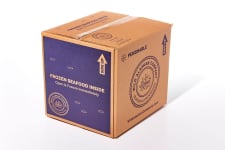Miso paste is a savory, salty ingredient that is a traditional pantry staple in Japanese cuisine. It is widely available around the world because of its unique qualities and versatility in cooking. Miso paste is used for adding flavor to marinades, soups, dressings, sauces, and more.
Miso paste is a great addition to your pantry if you cook seafood, as it pairs well with any species. Miso enhances the mild flavor of delicate species like Pacific halibut or coho salmon. It also complements the bold flavor of a robust fish like sockeye salmon or rockfish.
What Is Miso Paste Made Out of?
Miso paste is made from fermented soybeans that are sometimes mixed in with other grains like rice and barley.
Fermentation of the grain mixture produces live cultures in the miso paste, similar to cultures that are produced in yogurt and kimchi. Different conditions during the fermentation process also produce different types of miso with a range of colors, flavors, and aromas.
What Does Miso Paste Taste Like?
There are different types of miso paste, miso paste generally is very salty with varying degrees of umami, a Japanese term that describes a savory characteristic in foods.
Miso paste can taste a bit like store bought bouillon, because it’s so concentrated in flavor. However, when used in balanced concentrations, miso can have a very savory and earthy flavor that’s reminiscent of mushrooms, parmesan, or something meaty.
Types of Miso Paste and How to Use Them
Red miso
-
Color: Red miso has a reddish color.
-
Taste: There are different types of red miso, but generally red miso tends to be saltier than white or yellow miso pastes.
-
When to use: Red miso also usually has a more pronounced umami flavor, making it a good choice for strong preparations, marinades, and sauces.
White Miso
-
Color: White miso has a pale yellow appearance, compared to other varieties of miso.
-
Taste: Generally, white miso has a sweeter, milder, and less salty flavor than other miso pastes.
-
When to use: White miso adds subtle umami flavor to delicate sauces, dressings, and even miso butter.
Yellow Miso
-
Color: Yellow miso has a more pronounced yellow appearance than white miso.
-
Taste: It doesn’t have the sweetness of white miso. Instead, it has more umami and is a bit saliter. Yellow miso is milder than red miso.
-
When to use: Yellow miso is a great option for subtler uses in marinades, soups, and sauces.
Is Miso Paste Good for You?
Many fermented products that contain live cultures have purported health benefits. Since miso paste contains live cultures, you may be able to benefit from the presence of these cultures. Miso paste also contains some essential nutrients that can help support health. Cooking reduces the potential health benefits of miso paste, since this process destroys the live cultures in the product.
For folks who need to watch their salt/sodium intake, it’s important to know that miso is high in sodium, like salt or soy sauce. A little goes a long way, in terms of cooking with it, but please adjust the amount of miso paste you consume in accordance with your health goals.
Where to Buy Miso
Miso paste may be found in the refrigerated aisle of the grocery store, depending on how widely-stocked your local market is. Since it’s a product that contains live cultures, it typically is refrigerated. However, there are brands of miso paste that come in vacuum-sealed packaging and don’t require refrigeration, so you might also be able to find miso paste in the same aisle where you would expect to find soy sauce.
Miso paste can also be found at a local Japanese market or store that carries a variety of East Asian ingredients. You can even find good quality miso paste online from specialty vendors.
How to Store Miso
Miso paste needs to be stored in the refrigerator. If you’ve purchased miso paste in vacuum-sealed packaging from an unrefrigerated section of your local market, you’ll need to store it in the refrigerator once it’s opened.
It’s best to use miso within a year of purchasing for best flavor, but miso itself does not have an expiration date due to its high salt content. Miso paste is good indefinitely, when stored properly, though it may darken over time due to dehydration or oxidation.
If you’re not sure that miso has been stored properly, make sure to look for signs of spoiling before using the product. Do not use miso that has mold growing on it or any miso with off-smells that differ from the normal smell of miso.
What Can I Substitute for Miso Paste?
There is no exact substitute for miso paste, but there are different ways to add umami to your meals using other ingredients that you might already have in your pantry:
-
Soy sauce: Soy sauce has the umami factor that plain salt lacks. Like miso, it’s made from fermented soy beans. If you’re looking to make a sauce or soup that includes a bit of miso, try adding soy sauce instead.
-
Fish sauce: Fish sauce is a fermented fish product that has a very pungent smell, but when used sparingly in dishes, adds a bright umami flavor. Like soy sauce, this can be used to flavor sauces and soups.
-
Doenjang: Doenjang is a Korean ingredient made from fermented soybeans that has a salty-savory flavor that is comparable to miso paste. It’s also similar in texture. You can try substituting doenjang for miso paste in glazes, sauces, or marinades. Doenjang can also be dissolved into water or stock to create a soup base.
-
Tahini: While tahini has a very different flavor profile than miso, it has a similar color and texture that make it a decent miso substitute. You can combine a little bit of soy sauce with tahini to use in dressings to mimic the texture and flavor of miso.
Ways to Use Miso In Cooking
As a thick, salty ingredient, miso paste adds both heft and flavor to sauces, glazes, and marinades. It can also be mixed with room temperature butter to make a compound “miso butter” to serve as a topping for a variety of foods, including fish, vegetables, and bread.
Miso is also dissolved into water or stock as a base for soup, like a classic miso soup, Traditionally, miso is mixed in toward the end of cooking to help preserve the live cultures contained within the miso paste.
Note: Hot temperatures destroy the live cultures, which may reduce some of the health benefits associated with fermented foods. However, miso paste can still be used as a flavorful addition to any meal.
What is miso paste used for?
Best Miso Seafood Recipes
Miso Maple Broiled Coho Salmon
 Few things come together so perfectly as the union of mirin, miso and maple on a portion of delicate coho salmon.
Few things come together so perfectly as the union of mirin, miso and maple on a portion of delicate coho salmon.
3-ingredient Air Fryer Miso Sablefish
 This recipe for air fryer miso sablefish gives this rich, buttery fillet a delicious contrast in texture. The sablefish skin becomes crispy and light, picking up a savory char as it air-fries, while the fillet stays flaky and moist.
This recipe for air fryer miso sablefish gives this rich, buttery fillet a delicious contrast in texture. The sablefish skin becomes crispy and light, picking up a savory char as it air-fries, while the fillet stays flaky and moist.
Sheet Pan Salmon with Miso-Honey Dressing
 Sockeye salmon is paired here with crunchy snap peas and an umami-rich miso dressing, which makes for an ideal lunch or dinner in this sheet pan meal. Look for a red or brown miso, if you have the option at your local grocery store or Japanese market, as these darker miso pastes have deep nutty, caramel flavors that work especially well for this recipe.
Sockeye salmon is paired here with crunchy snap peas and an umami-rich miso dressing, which makes for an ideal lunch or dinner in this sheet pan meal. Look for a red or brown miso, if you have the option at your local grocery store or Japanese market, as these darker miso pastes have deep nutty, caramel flavors that work especially well for this recipe.
Miso Maple Sheet Pan Salmon and Eggplant
 This sheet pan salmon dinner is a perfect dish to pull together quickly for a cozy and fun weeknight meal. The earthy components of miso and sweetness of the maple syrup marry perfectly with winter squash and salmon, making it easily one of your new favorite dishes.
This sheet pan salmon dinner is a perfect dish to pull together quickly for a cozy and fun weeknight meal. The earthy components of miso and sweetness of the maple syrup marry perfectly with winter squash and salmon, making it easily one of your new favorite dishes.






